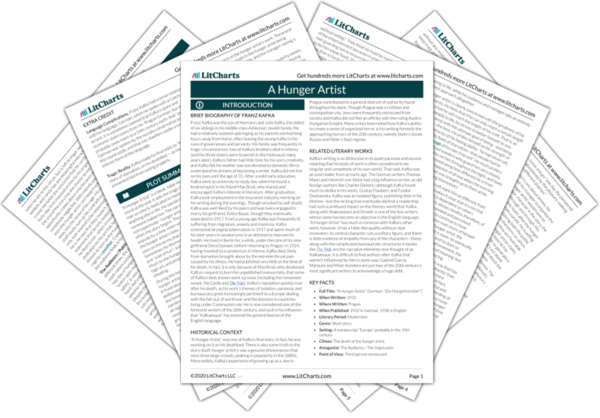“A Hunger Artist” is a bleak, fable-like story without any clear moral at the end. It tells the tragic tale of the hunger artist, a man so utterly dedicated to fasting that he denies himself anything else in life. He spends his life in a cage, only leaving if someone makes him. The narration is mostly told retrospectively—hunger artistry has already had its hey-day when the story begins. The reader is given a sense of its former popularity, a time when whole families would go and witness the hunger artist’s fasts. Though it was popular, it was never seen on the terms that the hunger artist would have wished. Sometimes his thinness scared people, and sometimes it was just “a bit of fun”—kids, understandably, found it terrifying. Much to the hunger artist’s frustration, it was never seen as high art, and people found it difficult to believe that he wasn’t cheating.
During this heyday, members of the public keep vigil over the hunger artist. They don’t take this job too seriously, though, and it frustrates the hunger artist that some of his warders deliberately try and give him a chance to sneak a snack—to him, the honor of his art is far too important to do so. Some of the warders take it more seriously, shining their torches at the cage all night, conversing with the hunger artist, and gratefully receiving a breakfast at his expense in the morning (a source of great pride for him). But as no-one will ever be willing to watch him throughout an entire fast, there is always a suspicion that the hunger artist is dishonest.

In those days, the hunger artist is “managed” by an impresario, whose care for him is really about protecting his investment rather than genuine concern. The manager imposes a forty-day limit to the fasts: the length of a town’s attention span when it comes to the artist. This always infuriates the hunger artist, who feels he is capable of much greater fasts. In fact, the hunger artist prides himself on never leaving his cage of his own free will—“that people had to concede.” At the end of these forty-day fasts, the impresario orchestrates big, gaudy displays that are not in the spirit of the hunger artist’s work. These end-of-fast “celebrations” culminate in the hunger artist being carried to a little meal set at a table, and the manager raising a toast to the audience.
Over the years, however, the hunger artist’s popularity wanes. Eventually, seeking a new audience and still naively believing that his greatest days are ahead of him, the hunger artist parts ways with his manager and joins the circus. Unfortunately for him, he is low priority for the circus staff, and is placed near the animal cages. He isn’t very visible to the general public, and most of his audience interaction comes during the intermissions in the main circus show, or when people are trying to get elsewhere on site. Finally he is free to fast beyond the forty-day limit and achieve his greatest heights as an artist, but without anyone to witness his fasting and give it meaning, even the hunger artist loses track of how many days he has been without eating.
Wondering what was wrong with a seemingly decent cage, an overseer and other staff look inside to find the long-neglected hunger artist close to death. The hunger artist says that he’s always wanted their respect, but when they offer it to him he chastises them for doing so. His last words are that he only fasted because he couldn’t find food that he liked.
Almost as soon as the artist he dies, the circus replaces him with a young panther. The panther is much more captivating than the hunger artist, and the last image of the story is of the audience clustering round the cage, enraptured by the muscular vitality of this new exhibit.







